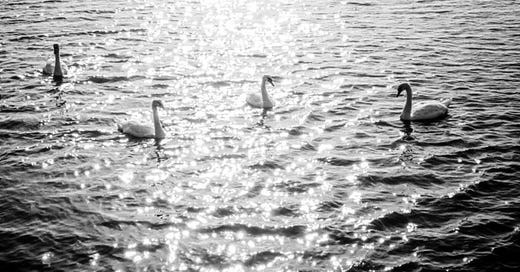No meditation today. I’m allowing my brain and body to lie fallow for a few days. But, here an excerpt from a forthcoming article I wrote to comfort, prod, and stir up your theological imaginations. — D.
There’s a Gaelic tale that might help us see this more clearly: the story of Tuan mac Cairill (Too-an mock Kar-ill), a man who lived through ages by becoming. Tuan does not rebel against time’s cycles, nor does he flee the flow of what he is and what he might become. Instead, he leans into it. When his tribe is wiped away, he is transformed—into a stag bounding through forests, a wildness tempered with sorrow. Then into a hawk soaring above the wide green land, seeing all from the sky’s bright heights. Then into a salmon, navigating rivers that shimmer with ancient babbling. Each form bears the wisdom of the last. Nothing is discarded; all is preserved, layered, renewed.
This, surely, is the Christian imagination at work. Renewal isn’t an escape or an amputation of what came before—it’s the ripening of one thing into another, a weaving of old wounds into glory. To be made new in Christ is not to erase ourselves but to be made to live into the fullness of our being.
Scars remain, yet they gleam with the light of resurrection. “New” here isn’t shallow or disposable; it’s the work of God’s hands that mend and restore.
But look at the modern cry for renewal: it is a house built on sand. A culture intoxicated with speed and surface will not ask what is being lost in the rush to reinvent. When we chant “new year, new me,” we flatten time into something mechanical—a cog to be reset rather than a sacred rhythm to inhabit. The old is something to discard, the self a product to be endlessly retooled. Yet each new version of ourselves only sharpens the gnawing ache, a sense that no amount of self-sculpting can satisfy the hunger for a deeper renewal.
Compare that hollow call with another ancient Gaelic tale, The Children of Lir. Here we see the meaning of true transformation, steeped not in self-will but in the rhythms of grace and suffering. Lir’s children are cursed to live as swans for nine hundred years, exiled to a landscape of cold waves and lonely skies. Yet the story ripens in those long years. The swans do not escape their pain but carry it, singing into it, letting the sorrow bloom into something beautiful and eternal. When their exile ends and their human forms are restored, it is only for a moment. The monk’s faith ushers them into a final transformation—not a return to what was, but a redemption that lifts them into eternity itself.
D.





Rest up D, and thank you for this lovely gift.